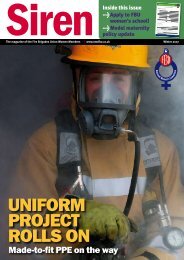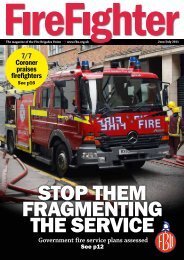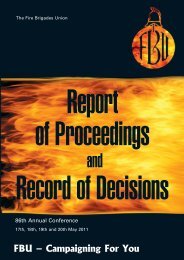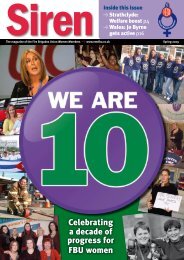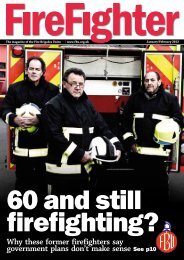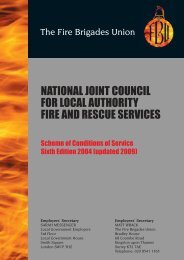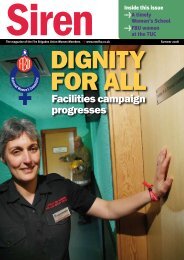Report - Fire Brigades Union
Report - Fire Brigades Union
Report - Fire Brigades Union
You also want an ePaper? Increase the reach of your titles
YUMPU automatically turns print PDFs into web optimized ePapers that Google loves.
SECTION B — FIRE AND RESCUE SERVICE POLICY<br />
their firefighters. A proper command and control function<br />
was not included in the specifications for FiReControl.<br />
20) At a FiReControl workshop at the BAPCO conference on<br />
22 April 2009 concerns were openly acknowledged. A very<br />
senior advisor to EADS on FiReControl faced a number of<br />
probing questions from FRS control officers who raised the<br />
issue of command and control at incidents.<br />
21) EADS made clear the system being provided to RCCs was<br />
call-taking and mobilising, with some limited incident<br />
monitoring because those were the contract specifications.<br />
There is NO command and control function, “it is not part<br />
of the specifications”.<br />
22) The contract specifications, he said, meant that at incidents<br />
officers would have laptops or MDTs and apart from that<br />
they would be “on their own”. The EADS advisor said it<br />
was only now that FRSs were starting to realise the lack of<br />
a command and control function in the contract<br />
specifications for the RCC technology and there needed to<br />
be “debate” about what happens.<br />
23) Our clear understanding is that on this point the<br />
contractors delivered to the specifications demanded of<br />
them. This serious omission was made by those who set<br />
out the contract specifications.<br />
24) The issue is not fully resolved and is of grave concern. At<br />
the very least, remedial work causing further delays and<br />
costs will have to be undertaken and a whole new area of<br />
“out of scope” work has been identified.<br />
25) It has significant implications for the staffing model, the<br />
technology, cost and delays. In our view this played a very<br />
significant role in the further delays which have emerged<br />
and at least some of the additional costs which have arisen<br />
as a result.<br />
26) The matter of how command and control is maintained in a<br />
practical sense with the breaking of the link between local<br />
FRSs and their local emergency controls is still not<br />
resolved. In answer to a parliamentary question from John<br />
McDonnell MP about the transfer of operational command<br />
and control arrangements to regional controls the fire<br />
minister Shahid Malik replied: “The responsibility for<br />
operational command and control will remain, as is now,<br />
with local fire and rescue services”.<br />
Unproven technology, under-development<br />
27) Until recently the proposed mobilising system from<br />
Ericsson – CoordCom – had never been deployed in the UK<br />
fire service market. To state that it was proven off-the-shelf<br />
technology was misleading and inaccurate.<br />
28) It is also worth noting that the FiReControl updates contain<br />
2 items which are “to be costed by EADS” relating to<br />
mobilising officers and dynamic mobilising, both standard<br />
features in existing suppliers’ systems. This again indicates<br />
that the original system specifications would be functionally<br />
less than the systems currently in use in some areas.<br />
29) It has now publicly emerged that Ericsson is to be dropped<br />
altogether in favour of Intergraph I/CAD as a mobilising<br />
system. Intergraph I/CAD has been tried and tested and<br />
failed in the UK fire service.<br />
30) In the proposed Cleveland tri-centre tests, Intergraph I/CAD<br />
failed. In any event, no system has been tried and tested in<br />
a national network of regional fire service controls, as none<br />
exists anywhere in the world.<br />
31) We anticipate the FiReControl specification may be more<br />
demanding than those specified a few years ago and we<br />
will need some convincing that a product – albeit an<br />
updated version – which failed a lesser test can now<br />
succeed in a more demanding one.<br />
32) We anticipate knock-on effects including potentially on<br />
DCMT1 and DCMT2 which we mention later in this<br />
submission. This may lead to further delays.<br />
Resilience<br />
33) Another major feature cited as essential was that of<br />
resilience. The choice of nine different systems does not in<br />
itself guarantee resilience, neither does 46 systems. The<br />
system architecture chosen by CLG for nine systems is then<br />
compromised further by only having three data centres, all<br />
of which are housed within three of the existing controls.<br />
34) Currently to render the FRS in England inoperable a<br />
considerable number of FRSs would have to fail or be<br />
taken out by terrorist attack (as well as their back-up<br />
facilities). Under the new scheme taking out the three data<br />
centres will render the whole RCC infrastructure unusable.<br />
35) Without the data centres then the Gazetteer options<br />
become unusable and dispatching impossible for such<br />
large areas. Current localised systems, even without<br />
Gazetteers, can mobilise with area knowledge to generate<br />
responses to an emergency situation.<br />
36) The call-handling capacity is appallingly low because of very<br />
low staffing numbers. As a result individual RCCs will hit<br />
spate conditions much more quickly.<br />
37) At times the national network will have very, very low<br />
numbers of staff on duty – less than 60. The entire national<br />
system could hit spate conditions when several RCCs hit<br />
spate conditions at the same time. This would happen<br />
during, for example, widespread weather events such as<br />
flooding or widespread snowfalls.<br />
Database generation<br />
38) The current proposal is utilising the NLPG dataset. This is<br />
meant to be another benefit of the proposed RCCS.<br />
39) This is utilised by many organisations and is a substantial<br />
database for mobilising. However it is somewhat different<br />
to the databases that FRS currently use. Many FRSs<br />
have started to switch their existing systems to use the<br />
NLPG database and are finding out at first hand the<br />
problems it poses.<br />
66 FBU Annual <strong>Report</strong> 2011





